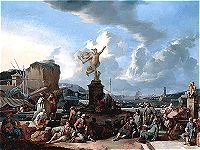 click to enlarge |
AN IMAGINARY HARBORJohannes Lingelbach SN 272, oil on canvas, c 1667 From: "The Pages"
|
ARTIST:
Lingelbach was German, but active in the Netherlands and Italy. His family settled in Amsterdam in 1634, where he probably trained as a painter. He spent two or three years in Rome and finally returned to Amsterdam in 1653. Lingelbach developed the Italianate genre and painted Italian scenes for northern collectors who wanted impressions of Rome, but not necessarily an historic reconstruction. Other Dutch artists, who had never been to Rome, imitated this genre.
SUBJECT:
This harbor scene depicts an idea of a faraway place (Italy), with street figures in foreground and a statue of Mercury, patron of commerce, in center distance. The background includes buildings, with a tall ship entering the harbor. Lingelbach has transported monuments/buildings from another place and included them in his landscape. A work of this kind is called a capriccio.
PAINTING:
Lingelbach was among the group of Italianate painters who specialized in painting bambocciade -scenes, small works representing trivial or base subjects related to contemporary Italian life. He fell in love with Italy and was fascinated by the life of the peasant. In this painting there are many figures representing different walks of life; e.g. the pilgrim (shirt decorated with shells), slaves in ankle chains, orientals, merchants – all people who may have been part of an Italian port scene. The prominent statue of Mercury (painted from an engraving of Mercury by Marcantonio Raimondi after Raphael) represents the protector of commerce, and the different nationalities reflect a peaceful coexistence. The painting was purchased by John Ringling at Christie’s in 1929. The work had disappeared in a sale in 1747 and was only identified in a London auction in 1920. When it was exhibited at Mauritshuis, The Hague, in 1990/91 it was the first time in 250 years that it was shown in the Netherlands.
HISTORIC CONTEXT:
The Italianate painters developed a style alongside the Dutch landscape school in the 17th century. Many of these “Italianates” had visited Italy, and features in their paintings reflect this influence - brilliant southern sunlight, bright local color, detail. The school also included those who had not even been in Italy, but were followers of the style.
The first Dutch painters to go to Italy were there in the 1620’s. These Netherlandish artists founded a fraternal organization called Bentvleughels (birds of a flock), for socializing and for mutual support. This organization lasted about 100 years; it was also known as Schildersbent (band of painters). They were given nicknames or “Bentnames”. Pieter van Laer, one of the early leaders, was called Bamboccio (big baby) from which came the Bambocciade scenes of Italian life. The Bentvleughels were disbanded in 1720 by papal decree because of their rowdy drunkenness.
Two distinct schools of landscape painting dominated Dutch art in the 17th century. One represented the local/imaginary scenery (Ruisdael, Looten) - the other showed scenes of Italy (Pynacker, Lingelbach).